Basically anything could be worth mentioning about Azerbaijan, since nobody seems to know anything about it in the first place. They’re kind of in the middle of nowhere in the minds of many Westerners, but also right along the convergence point of multiple historic empires, many of which considered it strategically critical for their interests.
But enough about that. What’s weird about it?
1) They’re home to the world’s biggest KFC
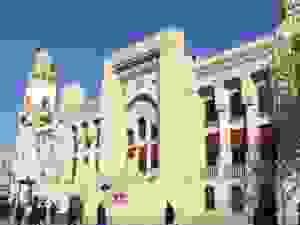
Housed in what used to be a rail station first built in 1926, and in need of major renovation by the time KFC took over, this massive, temple-esque site is now the home of the largest KFC in the world. It spans multiple stories, and the decor has a sense of grandeur that most Americans would find to be rather a humorous juxtaposition for a fast food restaurant—but one that is typical of Western chains opening branches in non-Western countries, where they often want to be seen as an aspirational, “special occasion” sort of place.
The KFC doesn’t take up the whole building, as there are some other shops in the ground floor, for example. But it takes up enough that its 1,600 square meters can fit 300 people.
2) It claims to be the landing place of Noah’s Ark
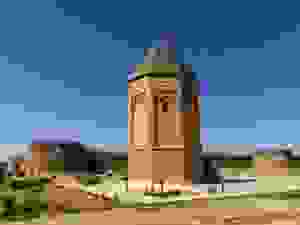
Over in the town of Nakhchivan, in a sliver of Azerbaijan cut off from the rest of the country, is a oddly-shaped mountain bulging randomly out of the ground, with a dent at the top, which is allegedly the site where Noah first landed after the flood. The city and region even derive their names from the legend, as Nakhchivan means “Noah’s town.”
It even claims to be the final resting place of the Biblical sailor, and you can visit his tomb at the edge of town, where a lonely, spiky tower is said to contain his remains.
Much like Columbus’ nationality, as well as many other contested celebrities, this claim is contested by others in the region, who say he landed elsewhere, or founded their town.
But if this is where the ark landed…where are all the raccoons?
3) They hang bread from trees

This is one of those odd-looking sights that probably needs to be explained, because the only thing you might imagine if you see something like this is either they’re trying to keep the bread away from the rats, or they’re trying to attract a bear.
But the real answer is far more adorable. Bread is considered sacred in Azerbaijan, and it’s something you’re supposed to share with friends. Wasted bread isn’t thrown away, as it’s considered too important to be discarded. People even say that they’ll occasionally kiss bread they find on the ground, and place it on a higher surface, off the ground and away from the dirt.
So when there’s leftover bread from a meal, they might just hang it from a tree.
4) The bathrooms have these tiny showers

I guessed wrong on this one, because I thought it was part of the Muslim tradition of washing one’s feet before prayer—which still seems like a sensible use of this contraption to me, but that’s not the point. This is actually the Azerbaijani version of toilet paper.
This wasn’t everywhere, but in most of the nicer bathrooms, this was ubiquitous. Toilet paper is actually kind of a Western invention, and although I doubt any Westerners are going to give it up anytime soon, I’ve heard from some Azerbaijanis that they think their way is better.
But most places with real bathrooms often had both, so don’t get too freaked out about it.
5) Sugar cubes don’t go in the tea
This is likely to cause confusion as well, because tea is always served with a million sugar cubes, but you’re not supposed to stir it into the tea. You’re supposed to take a sugar cube, place it between your teeth, and drink the tea right through it.
I don’t quite know the protocols of how long you’re supposed to keep it there. Maybe you’re supposed to hang on to it over the course of a whole teacup, or bite the first one after a short while, then add a new one after you’re done with it. Either way, it was a neat surprise, and a new take on something I’ve only ever seen done one way.
6) Tea is always served with candy

Speaking of tea, it’s served not only with sugar cubes, but almost always with something else that’s sweet as well.
Candy, fruit, dessert, and other sweets often arrive along with a teapot, and the selection can get quite extensive if you’re ever invited into someone’s home. In no time there might be a whole table full of candy and other treats.
It’s pretty great. But on the other hand, it’s probably at least partially responsible for the next factoid…
7) The old people all have gold teeth
In some cases, they have nothing but gold teeth. I saw a bus driver whose smile consisted of zero visible natural teeth. It was just shimmering gold, from one side to the other.
I’m not talking rich people here. Just about everyone above the age of forty seemed to have at least one of these, and plenty of people had several, even in tiny villages where people still travel on roads via donkey.
Gold has been used for a long time for tooth restoration, since gold can be shaped to look just like a tooth, is hard enough to last for many years, and is basically immune to corrosion. In other words, it makes a great replacement tooth if a natural one ever falls out.
Perhaps dental hygiene has improved somewhat in the last generation or two, which is why the gold teeth seem to be so much more common on the older Azeris than the younger ones. But maybe they’re just too young to need them yet.
8) Azerbaijan once produced half the world’s oil
That’s right, half. Back in 1901, before the Arabian peninsula basically realized its topsoil was just a big sandy blanket over its oil reserves, Azerbaijan produced half the world’s oil, leading to a booming economy, especially around the town of Baku, which is still the epicenter of the country’s oil wealth. Hitler even made a major detour this way while trying to conquer the Soviet Union, intending to use Azerbaijan’s oil to fuel the German war machine and the overall economy.
They have so much oil they can bathe in it. Literally. The town of Naftalan is famous for its crude oil baths, which were popular during the Soviet era for their alleged health benefits, and have been seeing a resurgence of popularity as of late.
And it’s not just oil, but natural gas, too. Several natural gas vents have been discovered, such as the sacred site of Ateshgah (which has long since run out, though it has since been replaced with a modern gas line to reignite the eternal flame of the temple), and the still-burning Yanar Dag, which is a 10 meter-long wall of fire emerging right out of the ground, and which has been on fire since the 1950s. This may or may not have something to do with Azerbaijan’s name meaning “land of fire” in Persian. Maybe.
9) Azerbaijan was (sort of) the first region to declare independence from the Soviet Union
So the first Soviet Republic to declare independence from the Soviet Union was Lithuania, in March of 1990, but the first region was Nakhchivan, in January of the same year. Nakhchivan has something of an independent spirit, which may come from its distance from the capital of Baku, or its current state as a disconnected exclave on the other side of Armenia. Either way, they’re proud of their independent sliver of Azerbaijani culture, and they were the first to officially let the Soviet Union know about it.
10) It’s home to over 40% of the world’s mud volcanoes

Of the 1000 or so in the world, 400 of them are in tiny Azerbaijan. Remember all that natural gas they have? It bubbles up to the surface and pushes forth the mud, often in tiny, gurgling bubbles, but occasionally in more violent eruptions, which can even be deadly.
For the most part though, they’re downright adorable. But I think it was probably good for the collective psyche of Azerbaijan that the name of the country means Land of Fire instead of Land of Exploding Mud, which it very well could have been.
11) It’s home to the world’s second-tallest flag pole
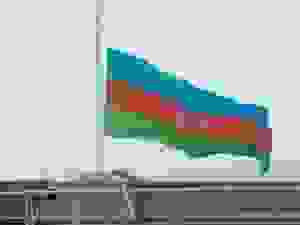
This thing is massive, at 162 meters tall. The flag itself is 70 by 35 meters, and it often gets so windy that they have to lower it to half mast.
For a while, it was actually the world’s tallest, when it was first completed in 2010, but has since been overtaken by the one in Dushanbe, Tajikistan.
The flag flies over a massive square often used for public ceremonies, and can be seen from the central city’s coastline, flying over the bay, visible from afar.
12) They bake bread in vertical ovens

Known as a tandoor (but spelled tendir in Azeri), these cylindrical ovens feature a blazing hot fire on the inside, and the bread is placed along the inner walls, where it’s exposed directly to the heat of the coals within the same chamber. The dough is sticky enough that they can just slap it on, and they fish it out with a metal hook when it’s ready.
The tandoor is common throughout Central Asia and other nearby regions, but it hasn’t quite caught on elsewhere. But the bread that comes out of it is great, so maybe it should.
13) It’s home to one of the last collective farms
This may or may not last for very long, but the town of Ivanovka is home to a population of Russian religious exiles who came over in the mid 19th century, and still work on one of the last remaining collective farms from the era of the Soviet Union.
The town is home to just a few thousand people, and is an unusual bastion of Russian culture in the middle of an otherwise culturally distinct country that has more or less tried to move on from its Soviet past. The collective economy of Ivanovka might not last forever, but it’s been working this whole time, as very few still do.


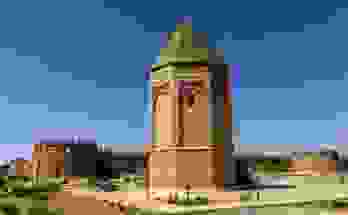
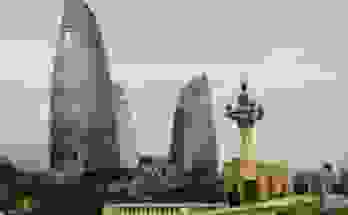
So….what happens to the bread hung from the trees? Does it go stale? Moldy? Do they take it down at some point in time and throw it away?
Holy cow that’s a big flag.
What a fascinating list.
I don’t know what they do with the bread. Usually if you leave bread outside, it won’t get moldy, because it’ll dry out and turn as hard as a brick. Maybe I’ll go back and ask.
This bread is later collected by people who hold farms. The hard bread is put in water and then is used to feed domestic animals like sheep, cows or hen.
Thanks for the info. For some reason, I didn’t ask while I was there.
Very cool info! Thank you. =)
Very nice. Interesting stuff about the loaves of bread. As for the “shower” in the toilet, I’ve been to India. I know!
Thank goodness I’m a girl as I’m always fully prepared with a packet of tissues stuffed down my handbag, or pocket somewhere. Ahem!
The bread thing is common to a lot of places. The poor in Morocco gather up the bags and put the stale bread to use.
The wet bathroom custom is not my favourite but it is in many Asian countries.
That KFC monument is Intense.
Great post!